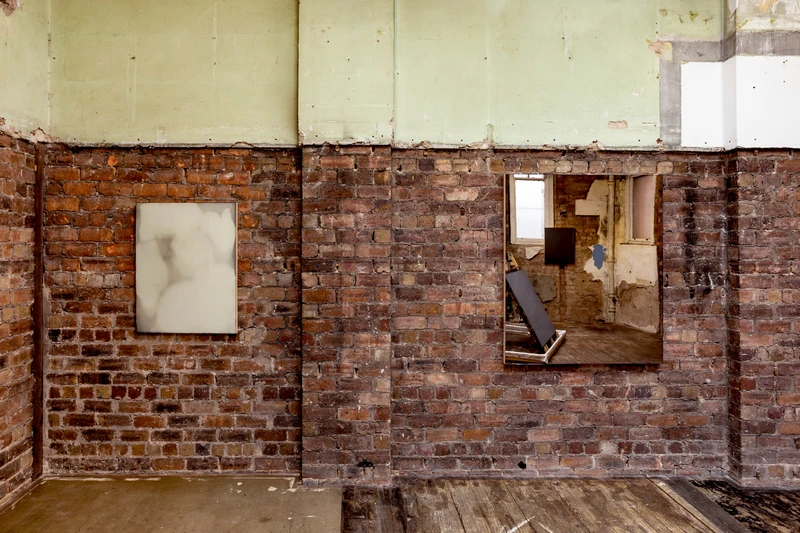Pádraig Timoney: Silts
29 Feb-20 Apr 2024


‘The mirror is the personal link between the human subject and its representation. Moreover, the mirror gazer may always legitimately hold on to his faith in the mirror’s power to reflect objective truth while at the same time he takes advantage of it as a tool for creating satisfactory artistic fictions.’
– Anne Hollander, Seeing Through Clothes (New York: Avon Books, 1980)
In light of Anne Hollander’s reflections, while Pádraig Timoney is the primary artist in Silts it is clear, given the nature of the work, that viewers too must take on an overtly inventive or creative role. They can choose what enters the frame of the pieces by moving around the room, shifting their gaze or tilting their head. Each person can reframe, pose and adapt expression – even capture their likeness in a mirror selfie. One might be tempted to rephrase Roland Barthes’ celebrated declaration in Image Music Text(1977), here the birth of the viewer must be at the cost of the death of the artist.
Timoney never fully recedes from the view though, he creates the works from scratch and his writing is etched onto the surface of the hand-poured mirrors – signing off with dates and titles. To make each piece, he cleans and prepares glass before laying it in a custom-made trough. As the process involves pouring a few different metal chemicals, there is a supporting structure that allows the glass to be raised to an almost vertical position for rinsing. When horizontal, the glass is treated with a tin solution which allows the eventual mirror metal – silver, copper, gold, or lead sulphide – to adhere properly. Following this a mixture of metal salt, activator and reducer is poured onto the glass. Whichever metal is used slowly forms and falls out of solution onto the glass producing a uniquely coloured mirror. Timoney encourages the inevitable imperfections resulting from this process as they indicate the facture and material conditions of seductive reflectivity and picturing.
In addition, some pieces have been made on frosted glass – essentially the exact same operation as a reflective mirror on clear glass but resulting in a noncoherently reflective surface, softly specular at higher magnifications. And in other works, the glass is mirrored on both sides, presenting a painted blank visual, where the inner eye alone can visualise an infinite regressive reflection. The artist plays a further trick on viewer. While it initially appears that he has created a hall of mirrors in Silt, several of the works are paintings, referred to as ‘Broken Mirrors’, in charcoal and acrylic with only the look of a reflective surface. As with the frosted mirrors, the moment of self-recognition is deferred and narcissism disappointed.
By assembling a variety of these pieces, Timoney forms a meditation on appearance and reality by working against a stable view of the space or the self, showing that each mirror creates its own fiction – blotting out details, bronzing or gilding the scene, or else cooling it with blue-silver tones. At the core of his practice is an exploration of the nature and implications of image production. If Timoney, the mirror-maker, creates the conditions through which a viewer sees themselves (or indeed is aware that they are not seeing themselves) then it’s possible to say that various types of portraits are continually being realised in Silts.
Pádraig Timoney (b. 1968, Derry; lives and works in Berlin). Selected solo exhibitions include: ‘waters of night’, Indipendenza Studio, Rome (2022) and ZDB Lisbon (2023); ‘Mean While’, Farbvision, Berlin, The Downer, Berlin (2021); ‘Superfare’, The Modern Institute, 14–20 Osborne Street, Glasgow (2020); Lulu, Mexico City (2018); ‘The Scrambled Eggs Salute The Trifle’, The Modern Institute, Airds Lane (2016); ‘A lu tiempo de…’, Museo Madre, Naples (2014); ‘Fontwell Helix Feely’ Raven Row, London (2013); ‘Shepard Tone’, The Modern Institute, Osborne Street, Glasgow (2012); and ‘The Fear of All Sums – Ten Million Dice to Weigh’, Void, Derry, Northern Ireland (2006). Selected group shows include: ‘Vestibulari’, Dal Basso L’Aquila, Abruzzo (2023); ‘THE NEVER ENDING ASYMMETRICAL INTANGIBLE ASSET MACHINE’, Ateliers Jeanne Barret, Marseille (2023) ; ‘Gli Incontri Della Luna’, Galleria Raucci / Santamaria, Milano (2022); ‘Il Valore dell’Arte’, Via Giacomo Carissimi 41, Rome (2019); ‘The Painting Show’, British Council touring exhibition, Limerick City Gallery of Art, Limerick (2017) and Contemporary Art Centre, Vilnius, Lithuania (2016); ‘Collected by Thea Westreich and Ethan Wagner’, Whitney Museum of American Art, New York/ Centre Pompidou, Paris (2016); ‘Terminal Convention’ at the former Cork International Airport (2011); ‘Frequency: Mark Garry, Pádraig Timoney, Hayley Tompkins’, The Hugh Lane Gallery, Dublin, Ireland (2009); ‘Un Monde d’Imag’, Frac Picardie, Beauvais, France and The British Art Show 5 (2000).